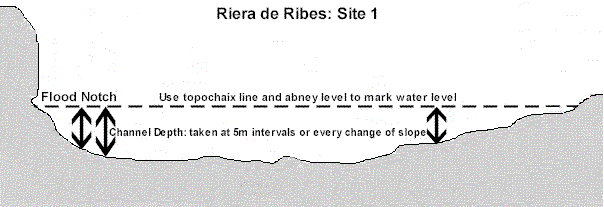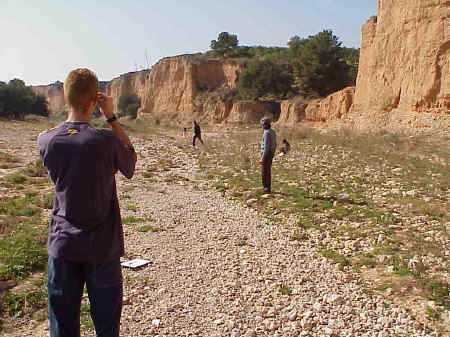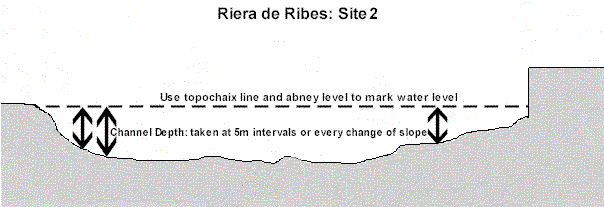|
River Study:
Riera de Ribes
How and why does the flood risk
vary between the north and south of the Sant Pere de Ribes area of Barcelona?
Background
Sant Pere de Ribes, a small town to the west
of Barcelona, is delimited to the north and west by the Riera de Ribes, a river
with a typical Mediterranean regime. This river is normally dry during the
summer months, but is subject to flash flooding which is most common during the
Autumn. A notch on a river cliff to the north of the town provides evidence of a
past flood level. The hydraulic radius, gradient and Manning n can be
used to calculate the discharge for the flood event and to analyse the
flood risk posed by the river, both in the vicinity of the river cliff and
further downstream. The risk to recent housing and camp site developments on the
river floodplain can be assessed together with the effectiveness of river
management schemes. Other factors that affect the flood risk, such as increased
urbanisation, forest fires, changing agricultural land use, drainage density,
drainage basin shape, reforestation, etc. can be analysed with the aid of
secondary data.
Tasks: Site 1
1. Measure the river cross-section
using the flood notch as the water level. Use a topochaix line secured
with ranging poles at both ends, levelled (using an abney level) with the flood
notch. This line marks the flood level. Measure the channel depth (using a
calibrated surveying pole and plumb line) between the river bed and this line at
5m intervals and at every change of slope. Distances across the river should be
measured using a measuring tape. See diagram below:

Record on Data Chart 1.
2. Identify the n value for Manning's co-efficient.
This measures friction or the resistance of the channel to river flow. This
depends upon the nature of the bed and bank material, vegetation cover and
sinuousity of the channel. Circle which one of the categories below best your
river cross section: only circle one value.
|
Stream description
Major streams <30m wide at
bank-full |
Channel state (sinuousity) |
| bad |
fair |
good |
best |
|
Regular reach with no boulders or weed |
0.060 |
0.050 |
0.035 |
0.025 |
|
Irregular and rough section |
0.100 |
0.080 |
0.050 |
0.035 |
|
3. Channel Gradient
Record the channel gradient using an abney
level as shown in the photograph below:

Record on Data Chart 2
4. Field Sketch
You will need to draw a field sketch looking up the river channel towards
your cross-section study site. This will require clear and detailed annotation
as follows:
- Evidence of management/flood prevention
- Land use adjacent to the river channel
- Vegetation size and type
- Bed load (shape/size)
- River landforms: river cliff, terraces
- Rock type
Record on Data Chart 3
5. Land Use Maps
Annotate the land use map using the following categories:
- Residential
- Agricultural
- Recreational
- Transport/communication
- Industry
- Flood prevention schemes
- Natural vegetation
- Current building works
Tasks: Site 2
1. Measure the river cross-section using bank-full as the water level.
Use a topochaix line secured with ranging poles or vegetation at both ends,
levelled (using an abney level). with the top of the river bank. This line marks
bank-full. Measure the channel depth (using a calibrated surveying pole and
plumb line) between the river bed and this line at 5m intervals and at every
change of slope. Distances across the river should be measured using a
measuring tape. See diagram below:

Record on DATA CHART 1
2. Identify the n value for Manning's co-efficient.
This measures friction or the resistance of the channel to river flow. This
depends upon the nature of the bed and bank material, vegetation cover and
sinuousity of the channel. Circle which one of the categories below best your
river cross section: only circle one value.
|
Stream description
Minor streams <30m wide at bank-full |
Channel state (sinuousity) |
| bad |
fair |
good |
best |
|
Lowland |
|
Clean, straight, no rifts or deep pools |
0.033 |
0.030 |
0.0275 |
0.025 |
|
Some weeds or stones |
0.040 |
0.035 |
0.033 |
0.030 |
|
Clean, winding, some pools or shoals |
0.045 |
0.040 |
0.035 |
0.033 |
|
More stones |
0.060 |
0.055 |
0.050 |
0.045 |
|
Sluggish reaches, weedy, deep pools |
0.080 |
0.070 |
0.060 |
0.050 |
|
Very weedy reaches |
0.150 |
0.125 |
0.100 |
0.075 |
|
Upland (no vegetation in channel except
at bank-full; banks steep) |
|
Gravel, cobbles and some boulders on bed |
0.050 |
0.040 |
0.035 |
0.030 |
|
Cobbles and large boulders on bed |
0.070 |
0.060 |
0.050 |
0.040 |
|
3. Channel Gradient
Record the channel gradient on Data Chart 2 using the same
method as for site 1.
4. Field Sketch
Record on Data Chart 3 using the same method as for site 1.
5. Land Use Maps
Annotate the land use map using the same method as for site 1.
DATA CHART 1: RIVER CROSS-SECTION DATA
| Site 1 |
Total Width: |
| Distance from bank |
0 m
(river cliff)
|
|
|
|
|
|
|
|
|
|
|
| Depth |
|
|
|
|
|
|
|
|
|
|
|
| Distance from bank |
|
|
|
|
|
|
|
|
|
|
|
| Depth |
|
|
|
|
|
|
|
|
|
|
|
| Distance from bank |
|
|
|
|
|
|
|
|
|
|
|
| Depth |
|
|
|
|
|
|
|
|
|
|
|
|
|
|
| Site 2 |
Total Width: |
| Distance from bank |
0 m
(river bank)
|
|
|
|
|
|
|
|
|
|
|
| Depth |
|
|
|
|
|
|
|
|
|
|
|
| Distance from bank |
|
|
|
|
|
|
|
|
|
|
|
| Depth |
|
|
|
|
|
|
|
|
|
|
|
|
DATA CHART 2: CHANNEL GRADIENTS
|
Site 1 |
Site 2 |
| Gradient Reading 1 |
|
Gradient Reading 1 |
|
| Gradient Reading 2 |
|
Gradient Reading 2 |
|
| Gradient Reading 3 |
|
Gradient Reading 3 |
|
| Gradient Reading 4 |
|
Gradient Reading 4 |
|
| Average |
|
Average |
|
|
DATA CHART 3: FIELD SKETCHES
|
SITE 1 (Looking Upstream)
|
|
|
|
|
SITE 2 (Looking Upstream)
|
|
|